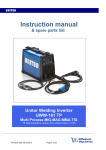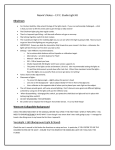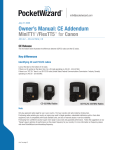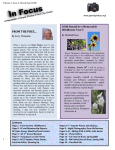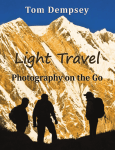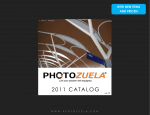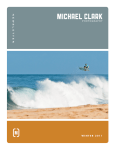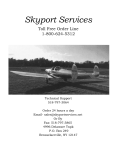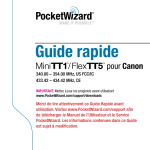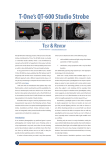Download Michael Clark Photography Summer/Fall 2015 Newsletter
Transcript
newsletter SUMMER/FALL 2015 contents Summer/Fall 2015 Newsletter 4 32 editorial portfolio An Explanation. An editorial about why this issue of the Aurelie Slegers hiking her mountain bike uphill near Tel- Newsletter is so late and my recent travels. luride, Colorado and the Grand Tetons looming above the 6 Snake River in Grand Teton National Park, Wyoming. news News items from the past six months including the re- 36 lease of my updated digital workflow e-book, images Making Fine Art Prints: An excerpt from my recently up- used by Apple, Hypersync Surfing, a few interviews and dated e-book, A Professional Photographer’s Workflow. getting the cover on Popular Photography magazine. 40 12 workshops excerpt perspective The Hustle Never Ends. How this profession only gets Detailed information on upcoming photography work- harder the longer you are in it and how I stay motivated shops I’ll be teaching in Hawaii, Patagonia, New Mexico after 20-years of shooting adventure sports. and Norway in 2016. 41 18 equipment review parting shot The Mestas family driving cattle near the Colorado and New Mexico border north of Taos, New Mexico. The Elinchrom Skyport Plus HS. A review of this incredible new transceiver that is changing the way I think about and conceive my photo shoots. copyright notice: 24 on assignment This Newsletter was created by Michael Clark for the Hypersync Surfing. An in-depth look at a portfolio shoot tion of any part of this Newsletter is allowed without earlier this year where I used HyperSync strobe tech- written permission. All images Copyright © 2015 Mi- niques to light up a surfer on a wave from 500-feet away, chael Clark Photography. All Rights Reserved. Contact using Elinchrom Strobes and the PocketWizard ControlTL me at [email protected]. To see more of my transceivers. work view my website at www.michaelclarkphoto.com. promotion of Michael Clark Photography. No reproduc- Cover Image: Mt. Moran and the Grand Tetons reflected in the Snake River at Oxbow Bend in Grand Teton National Park, Wyoming. Opposite Page: Daniel Coriz leaping off the wall at the Santa Fe dirt jumps just off Highway 599 in Santa Fe, New Mexico during an assignment for Elinchrom. Newsletter edited by Katherine Mast. newsletter 02 summer 2015 editorial An Explanation for this late Newsletter Non-Stop Travel: the Amazon, Europe, and all over North America T he last three or four months have been non-stop. I HS transceiver and the HS flash heads, which were re- have been traveling continuously for the last few cently announced. These two new products are incredibly months, with only a day or two in-between trips, some of exciting and have already changed the way I conceive of which were international. As a result, this is a combined and execute my assignments. If you haven’t seen them Summer and Fall Newsletter as I was too busy to put out already, you can find two blog posts I wrote for Elinchrom a Summer version. I also released a new updated version on their website which discuss the new products and of my digital workflow e-book, entitled A Professional Pho- how they work. In this issue of the Newsletter, I have also tographer’s workflow: Using Adobe Lightroom and Photo- included a review of these new products. shop, in August. The new e-book clocks in at nearly 500-pages, and over 100 new pages were added to the I have also been bouncing around teaching a few work- book. Needless to say, it has been a crazy summer and shops, speaking at several events and also shooting as- fall so far. signments. Grand Teton National Park, Chamonix, France, Las Vegas, Telluride, Yellowstone National Park, Houston, Back in July, I went back to the Amazon. It was just as New York City, San Francisco, Toronto and Seattle to brutal as last year, but thankfully we all came back in one name a few of the locations. It has been a whirlwind, but piece and no one was bitten by a snake, as happened the I have been shooting a lot of new work and will be able to previous year. This was my last trip to the Amazon for the release much of that here in the coming months. Until Tribes on the Edge project with my good friend Celine then, I hope you enjoy this expanded, larger-than-normal Cousteau. It was 108 °F and 100% humidity pretty much issue of the Newsletter. every day of the trip. We were soaked from head to toe the entire time. The images are under embargo until the Opposite Page: Aurelie Slegers catching some air while film comes out so this will be all that I can say about that downhill mountain biking near Telluride, Colorado. adventure...Stay tuned next year for the film and a lot more on that front. Recent Clients: Apple, Nikon, Red Bull Photography, Red Bull, Elinchrom, National Geographic, Rolling Stone, Out- In September, I was in Switzerland meeting with Elin- side, Outdoor Photographer, Popular Photography, Men’s chrom and trying out their new products the Skyport Plus Fitness (UK & Australia) and Powder Magazine. newsletter 04 summer 2015 news A Professional Photographer’s Workflow My digital workflow e-book has been updated for LR and PS CC 2015 I am happy to announce that I have updated my highly regarded e-book, Adobe Photoshop Lightroom: A Professional Photographer’s Workflow, which is now renamed A Professional Photographer’s Workflow: Using Adobe Lightroom and Photoshop, for Lightroom CC (2015) and Photoshop CC. This book is a 497-page digital workflow workshop and so much more in book form. Earlier this year, I revamped this e-book from front to back over a period of four months or more. It has been completely revamped and now includes an entirely new chapter on Fine Art Printing and also includes links to videos where you can watch me work up three images in both Lightroom and Photoshop. This book has been massively revamped and updated and includes the following new features: Links to 3 Videos showing how I worked up three images from start to finish, a completely new Chapter: Making Fine creating HDR images in Lightroom, soft Proofing in Light- Art Prints, a massively updated chapter on Storage Op- room CC and Photoshop CC, And much, much more… tions and Backup Strategies, a revised and updated chapter on Color Management Devices and Monitors, a re- The e-book is a downloadable PDF file that can be pur- vised and updated chapter on Printers for Color chased for the low price of $24.95. It is a week-long Management, an updated section on Camera Mainte- workshop in book form. It looks stellar on an iPad or any nance and Sensor Cleaning, a section on the new Dehaze similar tablet devices that can read PDF documents in Slider in Lightroom, creating Panoramas in Lightroom, color. To buy this one-of-a-kind ebook visit my website. newsletter 06 summer 2015 newsletter 07 summer 2015 Apple Retina 5K Ice Climbing Image Michael ‘s ice climbing image used to promote the latest 5k Apple iMac L ast fall, when Apple announced the new Retina 5K iMacs they used one of my surfing images to promote the new machine. Just re- cently I started seeing the ice climbing image shown at right being featured on the 5K iMacs. As always, it is an honor to work with Apple. They are one of the most prestigious companies anywhere on Earth and they drive trends in a way few companies can. This ice climbing image has proven to be incredibly popular, and it has also been used by quite a few companies to promote their products create a more dramatic set of images in the Ouray Ice but none have used it in such a visible way as Apple has Park using HyperSync lighting techniques. You can read with the 5K iMacs. about that shoot on my blog, on the Elinchrom website, or in my Spring 2015 Newsletter. In this ice climbing image, pro climber Dawn Glanc is ice climbing in the Ouray Ice Park in Ouray, Colorado. This My thanks to the team at Apple for using my images for image was created using a powerful strobe to light up the the latest marketing campaigns and to Dawn Glanc for ice climb and create something a bit different than your helping to create such a stunning image. It is images like average ice climbing image. The strobe was suspended this one that inspire me to push the envelope farther and on a long boom arm on a bridge above this ice climb. Ear- farther with my lighting and my photography so it is nice lier this year, I went back and worked with Dawn again to to see it get recognized by clients and on social media. newsletter 08 summer 2015 Hypersync Surfing on Elinchrom.com Lighting a surfer on a wave from 500-feet away using Elinchrom Strobes My recent project Hypersync Surfing went live on Elinchrom.com this summer. For this project, which was shot way back in February, Elinchrom and PocketWizard were kind enough to ship out quite a bit of gear, which allowed me to experiment more with Hypersync techniques and make the image shown at left (top of the web page) a reality. The above image was lit from 500-feet away, which is a first for a surfing shot. When I posted a link to the Elinchrom article on Facebook, I found out that in the 1940’s the US military devised a strobe that could light the ground from 10,000 feet at night. Hence, while lighting up a surfer from 500-feet away using strobes isn’t a unique brand new type of photographic image, doing so with off-the-shelf gear and a much, much smaller budget than the US military used back in the day is pretty amazing to think about, at least in terms of what is possible these days using Hypersync. For the full story on this project head on over to the Elinchrom blog, which has a full article, behind the scenes images and a behind the scenes video. Or you can skip down to page 24 and read about it right here in this issue of the Newsletter. Since this was shot, Elinchrom released their new Skyport Plus HS transceiver, which uses similar technology as the PocketWizard HyperSync triggers, but is much easier to use and allows for incredible results not possible with the PocketWizard triggers. See my review of the Elinchrom Skyport Plus HS transceivers on page 18. My thanks to Brian Bielmann, Ben Reed and Robin Dabney for all their help on this project—and especially to Ben Reed for the behind the scenes video. newsletter 09 summer 2015 Digital Trends interview An interview on one of the largest tech websites on the web D igitaltrends.com, one of the biggest tech websites on the internet, posted an interview with yours truly this past summer. The editors took some liberties with a salacious title and even reworked a few of my quotes to give it some “adventure dude” speak but otherwise this interview has some useful insight. The title of the article is, How to shoot insane action-sports photos (from a guy who has nearly died doing it) — check it out on digitaltrends.com. The subtext at the top of the article reads, “Imagine careening down a hill at breakneck speed on a mountain bike, or shooting whitewater rapids in a kayak. It’s one thing to capture these images from a distance; it’s another to get up close and personal.” It is always amazing to be featured on such large websites as it makes others aware of my work. My thanks to Bill Schiffner for tracking me down and putting this article together and to Digital Trends for featuring me on their website. APhotoFolio Interview An in-depth interview on the APhotoFolio Blog Rob Haggart has had a significant influence on my career. stuff.” In 2010, I signed on with APhotoFolio and have While he was the photo editor at Outside Magazine, he since won two PDN Photo Annual Awards for my web- once told me, “You adventure sports guys couldn’t light site. Rob does a great job with the website templates he your way out of a paper bag.” And he was right. A lot has offers as with everything else he does. I was stoked to changed since that lunch in 2002, but he nailed it and he answer questions for this interview as he asked quite a didn’t mince words. After that lunch, I went out and few in-depth questions I don’t get that often. My thanks bought a Hasselblad and some strobes and got to work. to Rob Haggart and Sven Brunso for their hard work on this—and the stellar websites. From Rob on Facebook: “Awesome interview with MiCheck out the full interview on the APhotoFolio blog. chael Clark. He’s never afraid to tell it like it is. Good newsletter 10 summer 2015 Popular Photography August 2015 Cover One of Michael’s most well-known waves images featured on PopPhoto Cover Earlier this year, while in New York City meeting with various clients and sponsors, I met with the fine folks over at Popular Photography magazine. I showed them my portfolio and this wave image in my portfolio wowed them. Amazingly, just a few months later, this image was featured on the cover of the August 2015 issue of Popular Photography. They also used the image inside the magazine as a double page spread in an article on shooting at the beach. This image was shot the day before the last Quiksilver in memory of Eddie Eikau big-wave surf contest in December 2009, where the waves at Waimea Bay on the north shore of Oahu were close to 60-feet tall. This wave was only ten or twelve feet tall since it was one of the waves that reforms about 60 feet in front of the beach. The rising sun had just hit the wave when this image was shot. Hence, all of the wild green and blue colors in the image. This image has been instant feedback on your work from an editor that sees published several times and even won an award in the hundreds of thousands of images each month is a privi- 2011 PDN Great Outdoor Photo Competition. lege and I certainly don’t take that for granted. My thanks to Popular Photography for choosing my image and using It is amazing to see what happens when you show your it on the cover! I can’t wait to get back to Hawaii this work in person to an art buyer or a photo editor. Getting winter and shoot more surfing images. newsletter 11 summer 2015 workshops Photography Workshops An overview of workshops and seminars with Michael Clark E ach year I teach several workshops on a variety of and you will spend a week of this trekking across the ice topics including adventure sports photography, cap and photographing the stunning Marconi glacier, big-wave surfing photography, and artificial lighting. Be- Cerro Torre, Fitz Roy and numerous other majestic peaks low is a listing of the workshops I will be teaching in 2016. rising straight from the ice. The experience may be simi- For the full description of these workshops and to find out lar to landing on the Moon, in that the landscape will be how to register, go to the Workshops page on my unlike anything that you have photographed before. This website. workshop is limited to six participants. At the end of this expedition, we will spend an entire day recovering in El Across the Patagonian Ice Field – Life on the Ice Chalten, working up images and critiquing the images Argentina - January 25 – February 4, 2016 created on this expedition. As far as we know, a photographic workshop has never This is a strenuous trek in a harsh environment. No tech- before been held on the Patagonian Ice Field. We are ex- nical skills or previous glacier walking experience are re- tremely thrilled to announce this first-of-its-kind expedi- quired, but participants must have camping and trekking tion for photographers. You have surely seen thousands experience prior to starting the expedition. You should be of images of the iconic mountains Cerro Torre and Fitz fit to hike with a 50 pound (25 kg) backpack for 6-8 hours Roy. But how many photos have you seen shot from the per day (unless you wish to hire a porter and trek just other side of these mountains? That’s right – not many. with your camera gear). Yet the views from the ice cap are far more striking than those from the easily accessible viewpoints by the road. For a detailed itinerary and much more information on The Patagonian Ice Field is the third largest mass of ice on this exciting workshop visit the Vertical Shot Expedition Earth and is a virtually untouched remote wilderness. website. The adventure will be led by two highly experienced Workshop fee: $5,900 mountain guides and the American outdoor photogra- Only 2 spaces left! pher Michael Clark. Michael’s work is used by many no- This expedition is run by Vertical Shot Expeditions, a Eu- table organizations. The expedition is eleven days long, ropean company, so payments will be sent to Europe. newsletter 12 summer 2015 Mentor Series Photo Workshop – Maui Video Surfing Photography Workshop Maui, Hawaii - February 10-14, 2016 Oahu North Shore, Hawaii - February 18-21, 2016 Storytelling is the step-by-step methodology of creating Join legendary surfing photographer Brian Bielmann and images and weaving them into a narrative. With an intro- adventure sports photographer Michael Clark for an ex- duction to Nikon’s latest HDSLRs from Nikon professional citing one-of-a-kind workshop that delves into the world photographers Michael Clark and Layne Kennedy at our of surfing photography. Brian is a top surfing photogra- Maui Video Workshop, you’ll capture the big moments pher who has been shooting the sport for more than 35 and everything in between, creating a story worth years. Michael brings his adventure photography skills telling. and knowledge as well as his in-depth experience with digital workflow to round out the workshop. At Old Lahaina, you’ll learn how to capture the sights and sounds of an authentic Luau as well as the motion of the This 4-day workshop combines daily photo shoots at dancers in the evening light. The next morning is filled world-class surfing locations, lifestyle photo shoots and with the opportunity to photograph the famous Lao nee- classroom instruction. We will be spending half of our dle rock formations covered in green moss that hover time shooting in the early mornings and in the late after- over the blur of the rivers. noon and evenings when the waves and the light are at their best. The other half of our time will be spent in the At Ho’okipa Beach, “the home of surfing,” you’ll capture classroom. All of the classroom instruction will be cen- the action of wind surfers riding the waves. You’ll then tered around image critiques, discussions on gear, strate- have the opportunity to shoot the close-up details of tra- gies and the business of photography as well as in-depth ditional lei making, a Polynesian ritual using braided discussions on shooting surfing. We’ll also cover digital leaves, flowers and shells. Alongside your mentors, you’ll workflow in detail using Adobe Photoshop Lightroom and gain experience using panning and motion blur tech- Photoshop. niques on the pro mountain bikers soaring through trails in Makwao Forest. Finally, conclude your Maui video with The workshop is scheduled during a period where large the chance to include the details of a traditional Hawaiian waves hit the north shore frequently. Though we cannot pineapple farm with portraits of the locals. predict or guarantee the wave size or surfing conditions, the north shore of Oahu serves up sizable waves on a To better understand the editing process, we will have a nearly daily basis. Depending on the waves, we will video editor on site to help with the editing process. Ha- choose the best locations for shooting and we will also waii will serve as the backdrop to your video story and schedule lifestyle shoots that help to fill out our coverage you’ll certainly want to share it when this Mentor Series of the world of surfing. video workshop is complete. Sign up today! For more inThe cost of this workshop is $1,295.00 per person. The formation visit the Mentor Series website. newsletter 13 summer 2015 same rate applies for each participant regardless of fill flash, and battery-powered strobes, and autofocus whether they are doing photography and participating in techniques. the workshop, or not. A deposit of $500 is required to secure your spot on the workshop. Final balance will be Classroom time includes daily editing and critiquing ses- due no later than January 15, 2016. sions and one-on-one meetings with Michael. In addition, Michael shares his insights and experiences in the If you’ve always wanted to shoot the amazing sport of adventure marketplace, including career development, surfing and document the surfing lifestyle, then now is portfolios, and how to shoot for stock, editorial, and com- the time to register. Remember, there will be limited mercial clients. For a detailed itinerary and much more space available for this workshop. When they’re spoken information on this workshop visit the Santa Fe Work- for, that’s it. If you have any questions before registering, shops website. send us an e-mail with any inquiries to [email protected]. To register for the workshop send me an Cost: $1,250 plus $65 Model Fee email and I’ll send you a payment request for the deposit and a packet of information about the workshop. Photography Sailing Expedition in Arctic Norway Lofoten islands, Norway - August 20 – 27, 2016 Adventure Photography Now in its third edition, our sailing and photography ex- Santa Fe, New Mexico - May 9-13, 2016 pedition to the Norwegian Arctic islands of Lofoten is a Adventure photography can be an adventure in itself, in- rare chance to photograph pristine coastal locations volving breathtaking locations, extreme conditions, and which are inaccessible to others. To us, sailing rather than working with elite athletes in risky situations. It requires a driving is the most logical way to fully experience and ex- host of skills, including technical excellence with the plore these stunning islands. camera, familiarity with a sport, and the ability to be mindful of your goals and your safety at all times. This small-group expedition (with a maximum of six participants) will use a very comfortable 47ft (14m) yacht Designed for intermediate to experienced photographers, built in 2012. The group will be guided by the renowned this workshop concentrates on creating unique images of outdoor photographers Michael Clark and Vlad Donkov. rock climbing, whitewater kayaking, mountain biking and The adventure starts in Svolvaer, the capital of the Lofo- trail running. Working with elite athletes and northern ten Islands, and follows the coastline of the awe-inspiring New Mexico’s incredible landscape as our backdrop, we mountainous islands, wild fjords and passages. explore innovative ways to capture the essence of each sport and location. Topics covered during the week in- This sailing adventure is suitable for people without any clude research and preparation, composition and camera previous sailing experience. However, participants should angles, equipment selection and use, using natural light, be adventurous by nature and ready to endure long days. newsletter 14 summer 2015 Cerro Torre looming over a section of the Patagonia Ice Cap in southern Argentina. On the Patagonia Ice Field traverse we will pop out from behind Cerro Torre on the least few days as we head back to El Chalten. This will be an incredible adventure and I hope you can join us. This expedition is about chasing great light and experi- this exciting workshop visit the Vertical Shot Expedition encing places that most people never get to see! website. Sailing presents us with plenty of opportunities to take Workshop fee: $4,500 photographs from unusual viewpoints and to reach loca- Please Note that this expedition is being run by Vertical tions only accessible by sea. In addition to the yacht, we Shot Expeditions, which is a European company so pay- will use an inflatable boat with an outboard engine. This ments will be sent to Europe. will enable us to land at wild beaches and explore our Workshop Testimonials surroundings on foot. There will be good chances of observing various whales and orca, as well as dolphins and seals. White-tailed eagles hunting for puffins and fish will “Within the short time I’ve been studying and practicing also frequently keep us company. photography, I have had teachers who are good educators, but not great photographers, and vice versa, but few For a detailed itinerary and much more information on newsletter who are both. Count yourself in these narrow ranks…I 15 summer 2015 went through 4 years of college and several careers get- goals and ask question after question after question. The ting less candid advice and encouragement than I got in 4 rough environments in which we photographed were days with you. For what it is worth, thank you for that.” – great fun to explore. Couldn’t be better.” - Tania Evans Brandon McMahon, Adventure Photography Workshop, “Thanks again for such a terrific workshop. I have taken Spring 2015 one other two-day Lightroom workshop, but your’s is the best!” - Vance Thompson, Lightroom Workshop, 2011 “Michael set an incredibly high bar for his workshop. He gave 110%, covered a broad range of topics and did an outstanding job.” - Chris Council, Adventure Photogra- “I really enjoyed the surfing [photography] workshop! It phy Workshop, Summer 2010 was great on every level. I really can’t thank you enough and I hope to take another of your workshops in the near future.” - Ben Reed, 2013 Surfing Photo Workshop “Thanks for running such a great workshop. I couldn’t have chosen better photo shoot locations, and the postshoot critiques were invaluable. It’s the first time I’ve had “Just wanted you know how much fun I had during the my work reviewed, and I learned a ton from each session. workshop last weekend! I learned a lot a look forward to While I didn’t go into the workshop expecting to pick-up doing other workshops with you.” – Jason Quevedo, Phil- too many marketing and business tips, I’ve come out of adelphia Mentor Series Trek, Fall 2009 last week inspired to set-up my photo website in earnest.” - Jeff Hylok, Adventure Photography Workshop, “Your workshop at Santa Fe was too good. The level of Summer 2010 expertise that shared was top-notch and I hope to repeat this experience again. Thanks for such a great workshop!” “I just finished Michael Clark’s Adventure Photography - Participant in the 2008 Balloon Fiesta workshop taught Workshop at the Santa Fe Workshops in April 2013. I had by Andy Biggs and myself. a terrific time with the group of people - one from China, another from Seattle, another from Wyoming, me from “My mind is still spinning and I can’t help but smile every Michigan - you get the picture that we came from every- time I think of the wonderful experience garnered from where. We came because of the Santa Fe Workshop’s our workshop. Between what I learned from the two of reputation of presenting an intense learning experience you, as well as from my talented classmates – this was a guided by fantastic instructors. We got both. Michael great experience, and I would do it again.” – Participant in Clark really knows his stuff and has a lot of excess energy, the 2008 Balloon Fiesta workshop taught by Andy Biggs which he focused on us, and he can also teach. He read and myself. our skills and weaknesses quickly and went to work to improve each of us technically. He sorted out our indi- For more information on my upcoming workshops, or to vidual goals, even when we couldn’t really articulate read more testimonials, please visit the Workshops page them. Then he gave us plenty of time to address those on my website. Hope to see you at a workshop here soon! newsletter 16 summer 2015 ADVERTISEMENT A Professional Photographer’s Workflow. Reality Check. Make Your Images Shine. PURCHASE & DOWNLOAD THIS E-BOOK AT WWW.MICHAELCLARKPHOTO.COM equipment review The Elinchrom Skyport Plus HS The most exciting new product I have seen in a long, long time Disclaimer: I am sponsored by Elinchrom reading these two articles if you get the and feel the need to disclose that here to be chance as they will provide a lot of back- up front with my readers. I was flown to ground information for this review. Switzerland in September to shoot demo images with the new Skyport Plus HS and was Here in this review, my intent is not to re- one of the first photographers to be able to hash those articles but to give a broader play with this new transceiver. Regardless of overall perspective on the new Skyport my sponsorship with Elinchrom this is one of Plus HS and why I find it so ground-break- the most exciting new product releases I ing for my work. In my opinion, this new have seen in a long, long time because it al- Skyport might just be the most funda- lows me to work in a whole new way with mentally game changing product in the my existing Elinchrom lighting gear. history of Elinchrom—and not just for I Elinchrom but perhaps even for any strobe have written quite a bit about the new company. I know that sounds like a big Elinchrom Skyport Plus HS already, statement. It is is not an easy to explain most of which has appeared on the Elin- how and why this new transmitter is a chrom website in two separate articles. huge leap forward for lighting. The new The first was an article that went live with features like being able to see your power the announcement of the Skyport HS, settings on the top LCD panel, being able which was entitled, The Hi-Sync Experi- to change the power settings on the ence, and the second article, entitled HS transmitter from up to 656-feet away or HSS: What’s the Difference, went live (outdoors), the AF assist beam, and the only a few weeks ago. The first article laid fact that it uses AA batteries, are nice out the main features of the Skyport HS new additions but none of those features and the second really delved into how Hi- are ground-breaking. The next level fea- Sync is different than HyperSync and tures, which really open up a whole new High Speed Sync (HSS). I highly suggest world of flash photography, revolve newsletter 18 summer 2015 Above is an image of Maxime Genoud in-line skating in an indoor skate park in Lausanne, Switzerland. This was shot while giving a demo to 80 Elinchrom distributors. To stop the motion we used the Skyport Plus HS along with two ELB400 pack and HS flash heads. The exposure settings for this shot were 1/8000th second at f/3.5, ISO 800 with a Nikon D4 and a 70-200mm f/2.8 Nikkor lens. We used smoke in the background and darkened the background using a high shutter speed. around the Hi-Sync capabilities that allow us to sync the transmitter has a lot of features packed into a small pack- flash with shutter speeds up to 1/8000th second. Before age. I am not a Canon shooter but the Skyport Plus HS we get into the Hi-Sync capabilities, let’s back up and transmitter reminds me a lot of the Canon ST-E3-RT give a little history. Speedlite Transmitter. Once I started using the Skyport Plus HS, it was easy enough to figure out the menus and The Skyport transmitters have needed an update for how to change the main settings like power output, sometime now. The old Skyports were relatively basic, groups, and how to get into the sub-menus. Getting in and this new one is anything but. When I first saw the deeper required only a quick perusal of the user manual. Skyport Plus HS, my initial impression was that it was The Skyport itself does not come with a full user manual fairly confusing. Turning it on was easy but this so if you need it, go to the Elinchrom Support page on newsletter 19 summer 2015 their website to download the Skyport Plus HS full user and you can choose any shutter speed and the Skyport manual. You’ll find the Skyport HS manual at the bottom Plus HS will automatically hop into Hi-Sync mode (when of the page under the heading “Last Updates.” using Nikon Cameras set to Auto FP (1/250s)—for Canon cameras you will have to set the Skyport Plus HS to HS mode). Now, I realize many folks will be confused as to how HiSync works. Let me explain. Hi-Sync and HyperSync for that matter work the same way. Basically, the transmitter is timing the flash so that the flash goes off before the shutter is released in the camera. To do this, the transmitter has to have incredible timing so that you end up using only a slice of the light emitted by the flash head as shown in the diagram at left. As shown in the same diagram, The above diagram, created by Bram Dauw at Elinchrom, shows how the Hi-Sync technology works. Basically, when using a flash head with a slower flash duration (as shown above) the transceiver times the flash burst so that we take a slice out of the highest part of the flash curve. In essence, we are only using a slice of the light emitted by the flash. because the shutter speed is shorter than the flash duration of the strobe, the slit moving across the sensor does so all while the flash is still emitting light, thereby lighting the entire image. As I have come to learn, Elinchrom is a strobe company that excels in technology. Perhaps that is their biggest Hi-Sync works best with flash heads that have a long area of expertise compared to the other strobe compa- flash duration so that the transmitter has some forgive- nies. They have strobo, delay and speed modes built into ness with the flash curve. As of right now, Hi-Sync works many of their current strobes. These modes are not found best with the ELB400 and the new HS flash heads. It also on any other strobe manufacturer’s units. They have also works with the ELB400 Pro heads, the Ranger “S” flash excelled with HyperSync, and now Hi-Sync technologies, heads, and the D-Lite RX, as well as some of the studio where few other strobe manufacturers have been able to strobes. For a full listing of the best gear to use with the make those technologies work. Just to be clear, Hi-Sync new Hi-Sync feature check out the Elinchrom compatibil- and HyperSync use the same technology, but since Hy- ity chart. For my Nikon D4 and D810 cameras, with no perSync is a trademarked name by PocketWizard, Elin- adjustments, I am getting great Hi-Sync results straight chrom had to choose a different name for their technol- away. There is a feature named Over Drive Sync (ODS) ogy. Hi-Sync is the built-in version of HyperSync that has that allows for moving the slice to a different part of the been perfected by Elinchrom. Because they know their flash curve. I have heard from some Canon users that ad- own strobes, they have been able to create an in-house justing the ODS settings resulted in much better results, version of HyperSync that works better than HyperSync so you will have to test this out on your own to see how it ever did. There is no gradation or clipping with Hi-Sync works for your camera. Regardless, the Hi-Sync technol- newsletter 20 summer 2015 Above: The Elinchrom Skyport Plus HS transceiver shown with two ELB400 packs receiving a signal from the transceiver. The top LCD panel shows you essentially everything you could want to know about the strobes and allows for changing almost every setting from the top of the Skyport Plus HS. Right: A portrait of BMX rider Daniel Coriz at the Santa Fe dirt jumps in Santa Fe, New Mexico. This portrait was created with four strobes: 3 ELB400s and a Ranger with a ring flash attached to it. All strobes were in synching in Hi-Sync mode including the Ranger ring flash. Image Data: Nikon D810, Nikkor 85mm f/1.4 lens , ISO 100, 1/8000th sec. at f/2.2. newsletter 21 summer 2015 Above is an image of Andrew Merrill catching some air while downhill mountain biking at the Mountain Village Bike Park near Telluride, Colorado. For this image, shot in mid afternoon, I opted to darken down the background by using a high shutter speed. The dark background was also helped by a thin cloud that moved in momentarily. Image Data: 1/2,500th sec. @ f/2.8, ISO 200, Nikon D810, Nikkor 70-200mm lens. ogy should work with any Canon or Nikon camera. very large apertures, creating a nice, out-of-focus background, as shown in the portfolio image on pages 32-33. With Hi-Sync, we are now free to use any shutter speed Using a large aperture (like f/2.8 or lower) does mean and aperture combination we want. When trying to over- that your autofocus will have to be dead on, especially for power the sun while shooting action, this means we can action images. I will continue testing the Skyport Plus HS freeze the action with a high shutter speed, which is and will be posting blogs with the results in the near fu- much more effective at stopping motion than a fast flash ture, so stay tuned. For more info on the new Skyport Plus duration. Alternatively, having the freedom to choose any HS, check out the two blog posts mentioned at the begin- aperture means we can shoot portraits wide open or at ning of this article and visit the Elinchrom website. newsletter 22 summer 2015 ADVERTISEMENT Exposed. The Life of a Pro Photographer. Revealed. The Secrets Behind the Images. ORDER THE BOOK ONLINE AT PEACHPIT, AMAZON OR BARNES AND NOBLES on assignment: HYPERSYNC SURFING CREATING A GROUND-BREAKING IMAGE USING HYPERSYNC FLASH TECHNIQUES newsletter 24 summer 2015 Five Elinchrom Ranger S “Standard” flash heads firing at full power while shooting surfing on the north shore of Oahu at Rocky Point. Image by Ben Reed. newsletter 17 winter 2015 Note: This article was originally published on the Elinchrom shipped four Ranger RX Speed AS packs, four S heads blog. At the time this was shot, Hypersync was the only game and four high performance reflectors half way around the in town. A few weeks ago, Elinchrom announced their own world to the north shore of Oahu. I brought with me one Hi-Sync transceiver, the Skyport Plus HS, which is much eas- extra Ranger setup, which made for a total of five Ranger ier to use and results in better overall images. The Skyport packs and heads. With this setup we had 5,500 Watt/ Plus HS is reviewed here in this Newsletter. Hi-Sync is an up- seconds of lighting power at our disposal. Additionally, dated version of HyperSync. Since PocketWizard has the PocketWizard sent four extra Power ST4 transceivers to name “HyperSync” trademarked, Elinchrom had to opt for a go on top of the Ranger RX Speed AS packs so that I different name even though technically HyperSync and Hi- could trigger all five packs using Hypersync with the Sync use the similar technology. PocketWizard Flex TT5 transceiver. I n photography, it is a rare thing indeed to create an In my experiments shooting ice climbing image that has never been created before without a and other sports with one flash head, I Hollywood-sized budget or extensive retouching in Pho- found that I could consistently overpower toshop. Over the last few years, I have been experiment- the sun from 60- to 70-feet (20m) away. In ing with the Hypersync capabilities of the Elinchrom shaded conditions, as with my latest ice Ranger RX Speed AS pack along with the Ranger S flash climbing shoot, I was able to light up the head bottom of a gorge almost 200-feet (60m) when using the PocketWizard ControlTL away with one Ranger pack and head. With transceivers. that in mind, I imagined that I could light up Ever since I first started playing with Hypersync I have a surfer on a wave at up to 500-feet (150m) dreamed of being able to overpower daylight and light up away with five Ranger packs and S heads a surfer on a wave from a far distance. I tried it out in Ta- working together. It took some trial and er- hiti with mixed results three years ago, but this year, with ror and a few extremely helpful assistants to the help of Elinchrom and PocketWizard, I was able to actually make this work. pool the extensive gear needed and head out to Hawaii to give it another try. As you can see from the image on For this shoot, I hired pro surfer Tommy page 29, we pulled it off. As far as I know, this is the first Ihnken, who lives on the north shore of Oahu. The waves image ever created of a surfer on a wave that was lit with on the day of the shoot weren’t exactly what we had strobes from 500-feet (150 m) away. To put that in per- hoped for; they were a bit unpredictable and small, but spective, the light from the strobes traveled a distance Tommy is known for catching some big air and he was equivalent to 1.4 football fields and overpowered daylight keen to give it a go. We opted to shoot at Rocky Point, (with the help of a cloud). which is a surf break known for huge airs off medium sized waves. Along with me on this shoot were three as- To make this experiment possible, Elinchrom graciously newsletter sistants: Ben Reed, Robin Dabney and the legendary surf 26 summer 2015 photographer and my good friend, Brian Bielmann,. All things that had to come together to get this image. It still three were indispensable on this assignment. Brian, as boggles my mind that we actually pulled it off. Brian was one of the top surfing photographers of the last 35-plus pretty amazed that we even got it to work, much less that years, told me that he had seen several photographers try we got an action shot. After we got “the” shot, I kept to light up a surfer on a wave with strobes on the beach, shooting for another hour or so. In that time we got sev- but they never had any luck unless they shot at night, and eral other shots that were fully lit but none of them mea- only from about 60-feet away. Hence, with this shoot, we sured up to the image shown on the next page. were being very ambitious. To capture the image, I shot with a Nikon D4, a Nikkor Once we got all of the gear to the beach and got set up, AF-S 400mm f/2.8 telephoto lens and a 1.4X Telecon- we had two and half-hours of daylight to work with. For vertor. This setup resulted in a 560mm f/4 lens. The ex- the first hour we got nothing of note. Not a single frame. posure for the resulting image was 1/1,250th sec at f/4 at With full sun hitting the surfer, I could see that in a few ISO 800. Because we were shooting wide open the lens shots we were filling in the shadows but we were not ac- had to have exceptional autofocus—and as you can see, tually overpowering the sun. We realized that the high it performed flawlessly. Gauging the distance of the surf- performance reflectors, when used from that distance, er from the strobes was a matter of looking at the focus were like lasers and that the light was going right past marker on the lens, which indicated a distance of about Tommy for many of the shots because he was moving all 500-feet. My shooting position was approximately 60 over the place with the waves. The next step was to have feet to the right of the strobes on the beach and basically two assistants direct the flash heads, moving them with in line with the flash heads. the surfer, so we could make sure we were hitting the surfer with the lights. After a few tries, we got some im- While I don’t consider this to be the best surfing image I ages where we could see that the lighting was working; have ever created, it is certainly different from any other we just needed to wait for something interesting to surfing image I have produced and is not a bad shot by happen. any means. As a proof of concept, it illustrates how Hypersync, when pushed to extremes, can be used with the Within a few minutes of putting two assistants on the Elinchrom Rangers to create images that never existed flash heads to move them with the surfer, the sun dropped before. behind a thinly veiled cloud and Tommy caught a decent air, one of only three he was able to get over the course of My thanks to Elinchrom and PocketWizard for believing the entire shoot. In that moment, everything came to- in this project and for sending out the extra gear to make gether and helped us created the image shown on the it happen. My thanks also to Brian Bielmann, Ben Reed, next page. With the strobes firing at full power I only got and Robin Dabney for helping me on this project. If you one image per flash, and the fact that the timing was per- want to see more on this project, check out the behind fect for this image is a small miracle. There are so many the scenes video on the Elinchrom blog. newsletter 28 summer 2015 Page 27 (top): Robin Dabney and I setting up the strobes and testing them at the beginning of the shoot. Image by Ben Reed. Page 27 (middle): Shooting with a Nikon D4, a Nikkor AF-S 400mm f/2.8 lens with a 1.4x teleconvertor resulted in a 560mm f/4 focal length. Image by Ben Reed. Page 27 (bottom): Five Elinchrom Ranger RX Speed AS packs with the PocketWizard ST4 receivers mounted on top of each pack. Image by Ben Reed. Above: The final shot from this shoot with Tommy Ihnken. Right: A screenshot of the behind the scenes video created by Ben Reed. To check out the behind the scenes video visit the Elinchrom blog. newsletter 29 summer 2015 Above: Michael Clark discussing the objective with prosurfer Thomas Ihnken at Rocky Point on the north shore of Oahu, Hawaii. Image by Brian Bielmann. Right: Michael Clark attaching the PocketWizard Power ST4 receivers to the top of the Elinchrom Ranger battery-powered strobes. Image by Ben Reed. newsletter 30 summer 2015 Right: For this shoot, we used the Elinchrom Ranger battery-powered strobes with the “S” Flash heads, which are optimized to work with HyperSync and also had the Elinchrom high-performance reflectors attached to each flash head. Image by Ben Reed. Below: Michael Clark and prosurfer Thomas Ihnken discussing the possibilities at Rocky Point on the north shore of Oahu, Hawaii. Image by Brian Bielmann. newsletter 31 summer 2015 portfolio portfolio excerpt Making Fine Art Prints An excerpt from my updated e-book A Professional Photographer’s Workflow T his is an excerpt composed of material from list here. After a brief stint in the physics world, I returned Chapter 6 of my recently updated e-book A Pro- to art in the form of photography. But, as an adventure photographer, I have never felt like my images were art. fessional Photographer’s Workflow: Using Adobe Lightroom and Photoshop. The updated e-book is a 497-page book that gets down to the nuts and bolts of a real world digital In the last few years, I have made a number of huge prints workflow. It starts out with a shooting workflow and then of my images. I recently had a client ask for thirty-five covers every aspect of the digital workflow, including large format prints up to 40x60-inches. During the pro- storage options so you don’t lose images. Chapter 6 is a cess of creating those prints, I felt more like an artist than new chapter entitled, “Making Fine Art Prints,” hence the I have in a long, long time. There was something familiar title of this article. What follows is the introduction from about putting ink onto paper and producing a tangible this chapter, a section entitled, “Why even bother making thing that would make people stop and stare. It was also Prints,” and a brief section on the hidden costs of printing very interesting to watch people interact with those huge on an ink-jet printer. For more information about A Profes- prints at the client’s offices and see their mouths drop sional Photographer’s Workflow: Using Adobe Lightroom and open with amazement, not knowing that the photogra- Photoshop and to purchase a copy please visit my pher was standing just next to them. Seeing my images website. printed, framed and hung on wall in the last few years has changed my perspective on printing and how important it The word “artist” is a word I use very sparingly. That term is to take the image all the way through to a tangible seems to be very much overused these days. Most artists product. that I know and respect never call themselves artists at all. I have been in and out of the art world my entire life, Modern digital photography relies on a wild array of high- having produced my first work at the age of three and a tech tools to create the final image. There is certainly a half, and then spending most of my upbringing in one art completely different feeling with photography than I had class or another. I started out drawing, then branched out in my early teens when I painted an image or molded an into just about every other form of art including painting, orb of molten glass. With photography that feeling of scratchboard, woodblock prints, lithography, glassblow- connection to the final piece isn’t as immediate. After all, ing, sculpture, photography and others too numerous to for any photograph I’ve created, I didn’t sketch every newsletter 36 summer 2015 contour of the image and render it by physically touching round-about way. Before we dive in, understand that I the paper or canvas. Instead, my camera captured the don’t work for, nor am I sponsored by, any of the compa- light, then I toned and worked up the image on a com- nies that make printers. So I am not here trying to sell you puter and the printer laid down the ink using very sophis- on why you should buy a printer. I am discussing the val- ticated technology on high-tech archival paper. Never- ue of printing your work and how it can improve the qual- theless, when the finished piece is on the wall and I watch ity of your photography. people interact with it, the end result is the same: the viewer is transported to another place, another state of In the Summer 2011 issue of my Newsletter, I discussed mind, and one hopes, is inspired by the image. an interview that appeared on the popular website aphotoeditor.com with legendary photographer Kurt Markus in WHY EVEN BOTHER MAKING PRINTS? my Perspective piece entitled, “Following Through.” In that interview, I was struck by some of his comments Why make prints of your images? This is a valid question where he said, “It takes guts to make a print. You know in this day and age of digital photography. It isn’t an easy you have to convince yourself that this is you, that you’ve question to answer, especially because printing is expen- made this and that you’re putting your name on it, and sive and unless you sell prints, it is tough to see why or you also have to believe that maybe somebody else ei- how it will improve your photography. I will explain why I ther can appreciate the work you’ve done or can appreci- think it is important to make prints in a rather ate the fact that this is you.” Kurt went on to say in that newsletter 37 summer 2015 interview, “I’ll boldly say this. Those people [who never Ok, so before you think I am off my rocker here, let me print their images] are never going to make it.” Now that explain my reaction to Kurt’s comments and my experi- is a bold statement, and I probably had the same knee- ences with printing my own images of late. About the jerk reaction when I read that as you are having right now. time I read this interview with Kurt Markus on aphotoedi- Over the course of my 20-year career, I haven’t printed a tor.com, I was making 13x19 inch prints on my Epson whole lot of my images—until recently. Before you blow R1800 and I had worked up a particular image file so that off Kurt’s statement I implore you to listen to his explana- it would print well. The print came out very nice, but tion and let this roll around in your mind over the next few while I was looking at it closely I noticed a bunch of weeks. Kurt went on to explain, “[They are never going to strange spots in the print. I checked my image file and make it] because they won’t be satisfied. They’ll just get low and behold, there were fifty or sixty dust spots right fed up with looking at their pictures on a computer moni- there in the image file. Now, this is a very specific exam- tor, because they’re going to surf the net, and they’re go- ple, but the point is that we look at prints with a much ing to look at other people’s pictures, and they are going more critical eye than we look at images on a monitor. to wonder what’s wrong with theirs.” He also said, “If you Also, with a monitor, we are relying on the monitor to make pictures, and pictures is your work, you might last show us an accurate preview of the image, which is why I for a few years, maybe even 10, but why would you want harped so critically on monitors way back in Chapter 2 (in to be a photographer and not take it all the way, all the the e-book). The point I am trying to get across here is way to a print? I do not get it.” that you really don’t see your image in all it’s full glory newsletter 38 summer 2015 until you print it. What you see on your monitor, regard- inkjet printer. For my Epson 9880, which is a huge 44- less of how amazing your monitor may be, is not the full inch printer, this means I have to spend about $800 each image. By printing your images and looking at those year on ink and paper just to keep that printer humming prints, you will either be depressed or inspired by your along. For my smaller Epson 3880, the cost of keeping it own work. Either way, those prints will act as motivation in top form is only a few hundred dollars per year. I bring to keep working on your photography skills. this up because anyone buying one of these ink jet printers, from Epson, Canon or HP may not be aware of this Another reason to print your work is to improve your added expense. Inkjet printers are made to be used. If you post-processing skills. If your prints look less than ap- let any inkjet printer sit around unused in a dry environ- pealing, that is a clear sign that you need to hone in your ment for several months it may never work the same post-processing skills and especially your color manage- again—if it works at all. For those in a more humid envi- ment. A good looking print is proof that you have worked ronment, this is less of an issue to worry about but still up your image with an eye towards excellence. If you are the printers need to be used regularly and I would sug- really obsessed with photography, and it just isn’t a pass- gest making, at a minimum, at least one letter-sized print ing fad, then the drive to take it as far as it can be taken every two weeks. involves printing your images. You will take your work to a higher level once you start printing your images on a I have personal experience with printer inks drying up. I consistent basis. This may or may not be a statement you owned one Epson printer that dried up after lack of use believe, but in the last few years I have found this to be over six months. I spent a few hundred dollars on ink car- true—and it is also the best reason I can give as to why it tridges trying to clean the nozzles to no avail. That print- is important to print your images. er, an older Epson R1800, never came back from the dead. I have also owned a Canon iPF5100, one of Canon’s HIDDEN COSTS OF PRINTING large format printers, which had one print head permanently clog up after a five month period without use and One of the factors you will also need to think about is needed to be replaced. One month later the other head maintaining your printer, especially if you live in a dry, clogged up and never worked again. That Canon was so dusty environment. To my knowledge, none of the manu- old when the print heads clogged up that it wasn’t worth facturers really talk about how to keep your printer hum- paying the $900 USD it would cost to replace the printer ming along without any issues. Here in New Mexico, it is heads. One other piece of hard won advice I should share particularly difficult to keep the inkjet nozzles from clog- is when buying a printer, spend an extra $50 to $80 and ging up because this is a fairly dusty and very dry envi- buy a cover for your printer. That will keep dust and grime ronment. I find that if I make one print each week that out of the printer and help it to keep working as new. keeps the nozzles primed and the printer working in excellent form. Having to make a print each week definitely To purchase this e-book please visit my website, where it means that there is a hidden cost to owning and using an can be purchased via PayPal. newsletter 39 summer 2015 perspective The Hustle Never Ends by Michael Clark W hen I started out as an adventure photographer, I that it would be all too easy to relax a bit and not work as knew it would take years to really establish myself hard as when starting out. For me, it was and still is the and solidify a career in photography. I had read some- new photographers who are full of energy and really where that it would take two to three years to go full-time pushing hard that make me push myself as hard as I can as a freelancer, and then another five to seven years be- to come up with new and exciting work. Those young fore I would be making decent money. Somehow, early on guns out there help keep my motivation high and keep I got it into my head that if I could make it to the ten-year me pushing the envelope. mark, I would have it made in the shade and assignments I started out shooting mostly for editorial publications, would be coming my way non-stop. then moved into shooting commercial assignments for Before I went full-time as a freelancer – almost 20-years advertising. After shooting a few “big-time” assignments ago now – I ran into James Balog and had a conversation I came to realize very quickly that with big sums of mon- with him about his work and career. I remember him say- ey at stake comes a huge amount of stress. Most of that ing quite clearly that it only gets harder the longer you stress is self-imposed because I know I have to come work as a photographer and that the continual hustle to back with images that will make the client happy. Deliver- get assignments never ends. That blew up my pre-con- ing images to the client that surpass their expectations is ceived notion about making it to the ten-year mark and also a serious form of motivation for me and always has then hitting easy street. He also mentioned that every been. year there are young photographers entering the profession who are hungry, willing to work extremely hard, and The past 20 years have taught me that staying motivat- who want to take his assignments. At that point, I was ed, however that happens, is key to a long career in this one of those hungry photographers. field. If I am not constantly pushing myself and my work and exploring new things, prospective clients will see Over the years, I’ve learned that, at least for the adven- that. Every year, I have to keep shooting portfolio images ture genre, finding motivation is key to moving your ca- or personal projects that take hard work and dedication reer forward. When I was starting out, I had an intense to pull off to make sure I am still relevant so that I can be desire to make amazing images and also serious motiva- around in this profession for another 20 years. The hustle tion to make a living. Once I got established, I realized never ends. newsletter 40 summer 2015 parting shot The Mestas family driving a herd of cattle on the Mestas Ranch in the middle of the Rio Grande National Monument near the Colorado/New Mexico border north of Taos, New Mexico. newsletter 41 summer 2015 ADVERTISEMENT Location Lighting. For The Outdoor Photographer. Realized. Shaping your Images with Light. PURCHASE & DOWNLOAD THIS E-BOOK AT WWW.MICHAELCLARKPHOTO.COM










































